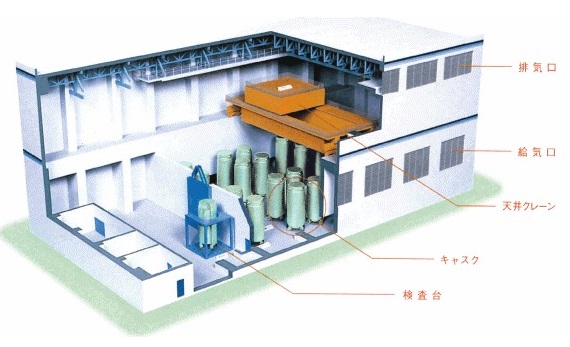Masahiro Kikuchi
August 23, 2017
I. INTRODUCTION
In this essay, Masahiro Kikuchi examines possibly effective barriers to a terrorist attack using anti-tank weapon on spent fuel stored in dry casks. He concludes that: “the facility operator should prepare an appropriate barrier to block the terrorist intrusion and an appropriate alert system for early detection of the breaking through the boundary of the site where the SF is stored.”
Masahiro Kikuchi is Executive Director of the Nuclear Material Control Center, Tokyo. This is a private study using open source information
Paper prepared for Workshop Reducing Risk of Nuclear Terrorism and Spent Fuel Vulnerability in East Asia co-sponsored by Nautilus Institute and Research Center for the Abolition of Nuclear Weapons, Nagasaki University, Nagasaki, January 20-22, 2017
The views expressed in this report do not necessarily reflect the official policy or position of the Nautilus Institute. Readers should note that Nautilus seeks a diversity of views and opinions on significant topics in order to identify common ground.
Banner image: dry cask storage plan for Hamaoka nuclear power plant from Chubu Electric Power.
II. NAPSNET SPECIAL REPORT BY MASAHIRO KIKUCHI
A VULNERABILITY RELATED TO DRY STORAGE OF SPENT FUELS
August 23, 2017
Purpose of the study
Generally, the dry storage of spent fuel (SF) has an advantage over the storage in the water pool from nuclear safety and economic point of views. The integrity level of SF transportation and storage cask has been examined mostly from safety point of views. Many cases of heat-resistant tests and pressure-resistant tests have been carried out. Penetration-resistance has been tested in small cases, for example, a collision of steel rod against the side of the cask.
We seldom see the study case of vulnerability of SF transportation and storage cask against the terrorist attack. For this reason, I will pose several trials to consider the vulnerability of the dry storage of SFs from nuclear security point of view against nuclear terrorism by using the open source information.
First, I identify the types of dry storage casks. Second, I suppose the plausible design base threat (DBT) against the casks. In the plausible threat, attacking by the anti-tank weapons is included. Finally, I consider the results of the study with several suggestions to the protection of the dry cask storages.
Configuration of dry storage
Three types of configurations of SF storage are currently considered as follows;
Type I. SFs are contained in the safer metal casks, and the casks are placed in a storage building,
Type II. SFs are contained in the safer metal casks, and each cask is covered by the concrete module. Each concrete module is placed in the exterior of building,
Type III. SFs are contained in the safer concrete casks, and the concrete casks are placed in the exterior of building.
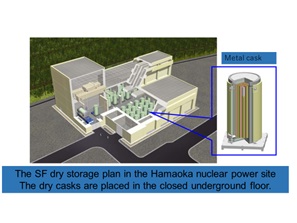
Figure 1: Type I storage
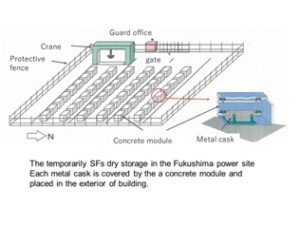
Figure 2: Type II storage
The SFs concrete cask is placed in the exterior of building.
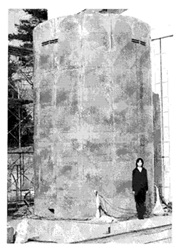
Figure 3: Type III storage
In case of Japan, type 1 and type 2 will be adopted.
The plausible Design Base Threat (DBT) related to the dry cask storage
Generally, the real DBT is not open to public and is kept secret by the national authority and the facility operator. In order to consider the vulnerability of spent fuel dry storage, I would assume one DBT based against terrorist attack.
The DBT is as follows;
- Small numbers of well-trained terrorists intruded into the nuclear site where the SFs stored under the dry condition.
- Each terrorist would equip totally 20kgs of light arms, including hand guns, rifles, light anti-tank weapons and explosives.
The assumed worst case is as follows;
- The terrorist would access the SFs dry storage place and destroy the safer metal cask by the light arms.
- Consequently, the SF contained in the safer metal cask is broken and the high radioactive material would be leaking from the cask to the atmosphere.
- Scenario of the terrorism would be as follows;
- The terrorist would break the wall of building or the fence of stored place and would access the safer cask.
- The terrorist would launch the light anti-tank weapon to the cask and would penetrate the cask to SFs themselves.
- Discussion points are the safer level of cask against terrorist attack by the light anti-tank weapons.
Offensive situation
According to the DBT, the size of typical light anti-tank weapons could be defined as less than 10kg weight and less than 1,000mm length because the light weapons with these sizes are easy to carry by hand. Janes Weapon handbook provides estimates of the capacities of anti-tank weapons. Notable points are the capability of penetration against a steel plate. Typical examples of the specifications (weight and length of the weapon) of the anti-tank weapons and their capabilities of penetration through a steel plate are shown in the table 1.
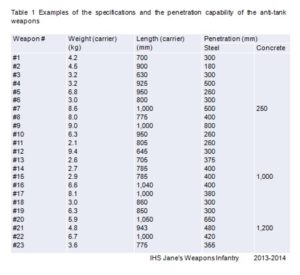
Typical types of light anti-tank weapon

Figure4: RPG-7 type light anti-tank weapon
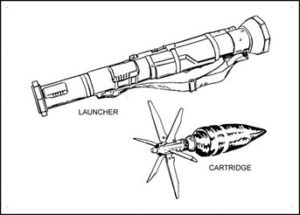
Figure 5: Rocket launcher type light anti-tank weapon
Defensive situation of the type I
The structure of the typical dry storage cask and a partial cross section of the cask are shown below.
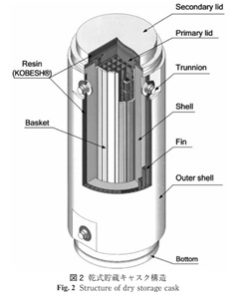
Figure 6: The structure of the dry storage
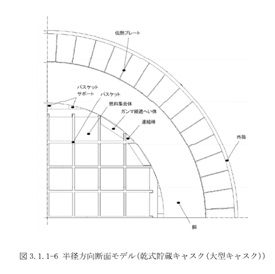
Figure 7: A partial cross section of the dry storage showing neutron absorption
Based on technical judgment from these two figures, the thickness of the stainless-steel shell is around 250 mm. The dry storage cask would be stored in the underground floor of the storage building. (see Figure 1)
Defensive situation of the type II
The same type dry storage cask would be covered by the concrete module and installed at the nuclear power site (See Figure 8).
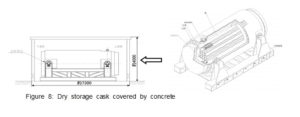
The thickness of the concrete module is around 20 mm.
The thickness of the stainless-steel shell is around 250 mm that is almost similar to the Type I described before.
The dry storage cask covered by the concrete module would be installed in the site field. (see Figure 2)
Defensive situation of the type II
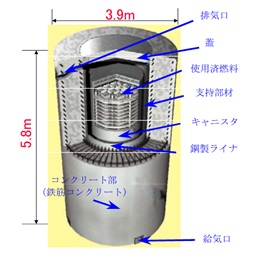
Figure 9: Concrete Shell Dry Cask
The thickness of the stainless-steel liner is around 130 mm.
The thickness of the concrete shell of reinforced concrete is around 680 mm.
The concrete dry storage cask would be installed in the field. (see Figure 2)
Discussion
I could identify several discussion points as follows;
General
- Average penetration power of light anti-tank weapon against stainless steel could be assumed to be around 380 mm (strongest power is 800 mm) from the data displayed in the table 1.
- The maximum penetration power could be achieved under the ideal incidence angle of metal jet from the weapon such as almost vertical the target.
- Generally, the power of metal jet which is flooded into the material will be decreased between different layers, such as a ceramic and a metal.
Analysis of the type 1 storage
- In case of the type 1 storage, as the thickness of the stainless-steel shell is around 250 mm, the cask might be penetrated by the anti-tank
- However, there might be a difficulty to use the weapon for the terrorist, that is the anti-tank weapon could not use in the closed area, because the explosion blast of the warhead would wound the terrorist himself who launched the weapon in the closed area.
- The important point for the protection is to prevent the terrorist from intruding in the storage area before using the weapons.
- The storage building including the resident guard forces could be assigned as the protection barrier.
Analysis of the type 2 storage
- In case of the type 2 storage, as total thickness of barrier, such as the concrete module and the stainless-steel shell, is around 450mm (200mm+250mm), the cask might not be penetrated by the weapon.
- In this case, the penetration power might be decreased, because there are several lengths of air distance between the concrete module and the metal cask. After the metal jet penetrated through the concrete module, the metal jet might be spread over the air.
- The important point for the protection is to prevent the terrorist from accessing to the storage place before using the weapons.
- The heavy barrier enclosed storage place and the resident guard forces would be assigned as the protection measures.
Analysis of the type 3 storage
- In case of the type 3 storage, even though total thickness of barrier, such as the heavy concrete shell and the stainless-steel liner, is around 810mm (680mm+130mm), the cask might be penetrated by the weapon.
- Because that the intensity of the concrete shell against the metal jet intrusion is weaker than the stainless steel, after penetrating the concrete shell, the thin stainless steel liner might be broken.
- The important point for the protection is to prevent the terrorist from accessing to the storage place before using the weapons.
- The resident guard forces would be assigned as the primary protection measures.
Conclusion
This study is based on simple assumptions combined with open source information. Many sources suggest many scenarios of terrorist attacks. Some terrorist may have the same information as my study.
As a conclusion, I would state that there is no sole surefire remedy to resolve all vulnerabilities related to dry storage of spent fuels. The terrorists might consider mixed attack tactics with their armed equipment. We should assume various DBT and intrusion scenarios to access the storage place other than the case of this study.
The important point is that the facility operator should prepare an appropriate barrier to block the terrorist intrusion and an appropriate alert system for early detection of the breaking through the boundary of the site where the SF is stored.
When we recognize that terrorists might intrude onto the site, the guard force must be able to arrest them at the access routes before reaching the SF storage place.
The concepts of the SF protection system must be similar to defense tactics for a fortress or a castle with appropriate logistics.
III. NAUTILUS INVITES YOUR RESPONSE
The Nautilus Asia Peace and Security Network invites your responses to this report. Please send responses to: nautilus@nautilus.org. Responses will be considered for redistribution to the network only if they include the author’s name, affiliation, and explicit consent


